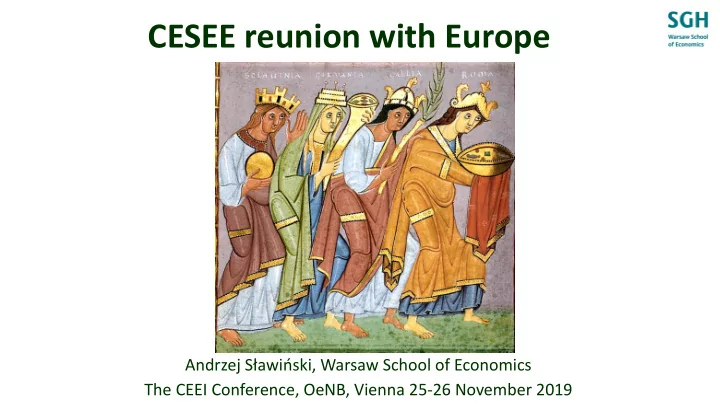

CESEE reunion with Europe Andrzej Sławiński, Warsaw School of Economics The CEEI Conference, OeNB, Vienna 25-26 November 2019
1. Exchange rate policy
The choices of exchange rate regimes in the early 1990s • Initial fixing of the zloty enabled Poland to overcome hyperinflation (600%) • Its subsequent gradual floating facilitated adjustments in the BOP • Currency boards were a rational choice for the Baltic states and Bulgaria, but exposed them to unsustainable lending booms
Current account balance (% of GDP) 10,0 5,0 0,0 -5,0 -10,0 Bulgaria Czechia Estonia -15,0 Latvia Lithuania Hungary Poland Romania Slovakia -20,0 -25,0 -30,0 2004 2005 2006 2007 2008 2009 2010 2011 2012 2013 2014 2015 2016 2017 2018 4 Source: Eurostat; NBP
The 1990s proved that interventions on FX markets can be effective • Stabilizing speculation within the zloty’s band in the mid - 1990s • Smoothing out the appreciation of the koruna in the early 2000s • Successful defence of the forint’s 15% band in 2003 • Keeping the koruna’s ceiling of 2013 -2017 with few interventions
2. What made stabilizing inflation in the 2000s easier than initially expected?
• Enhanced central banks’ credibility due to successful disinflations of the 1990s • CESEE countries’ increasing export potential allowed them to use nominal appreciation as an inflation-stabilizing tool • Global fall in inflation • Participation in the European GVCs facilitated trade deficits reduction and exchange rates stabilization
Source: UNCTAD statistics 30,0 35,0 40,0 45,0 50,0 55,0 % 33,1 36,5 37,0 38,3 39,4 40,9 Global value chains (share in exports) 41,8 42,8 42,6 42,7 43,7 43,5 43,9 45,9 48,0 47,8 49,6 52,8 50,7 49,6 51,0 52,5 53,0 52,9 52,3 50,4 49,7 49,3 49,0
The GVC impact on Poland’s trade balance EUR bn 5 3 1 -1 -3 -5 -7 2000 2001 2002 2003 2004 2005 2006 2007 2008 2009 2010 2011 2012 2013 2014 2015 2016 2017 2018 2019 products related to GVC activities fuels & primary goods other manufactured goods
3. The 2007-2009 crisis: Why was there no exit strategy in Poland?
FX loans complicated monetary policy Bank balance sheet Mortgage loans indexed to CHF Zloty appreciation PLN CHF CHF
• Tightening LtV and DSTI ratios in 2006 directed FX loans mainly to more affluent borrowers • The way in which the bad debts problem was solved in the early 1990s had long-term positive effects
FX loans were granted mostly to high-earners 13 Share of mortgage borrowers by income decile Distribution of mortgage borrowers by DTI 9% 30% 8% 25% Per cent in a given income decile 7% 6% 20% Per cent 5% 15% 4% 3% 10% 2% 1% 5% 0% 0 4 8 121620242832364044485256606468727680 0% 1st 2nd 3rd 4th 5th 6th 7th 8th 9th 10th Households with PLN mortgage Income decile Households with FX mortgage Households with PLN mortgage Households with FX mortgage Source: NBP calculations based on PHBS data Source: NBP calculations based on PHBS data
4. The adoption of the euro
The 2007-2008 crisis made some new Member States cautious about the timing to join the Eurozone • Floating of the zloty brought some positive results, such as reducing external imbalances and stabilizing the REER • The small differences in economic developments in Slovakia and the Czech Republic reflect diminishing importance of exchange rate regimes
Nominal and real effective exchange rates of the zloty (index, 2000M01 = 100) 150 140 130 120 110 100 90 80 70 2000 2002 2004 2006 2008 2010 2012 2014 2016 2018 NEER REER CPI REER ULC Source: BIS and OECD data
• The decreasing exchange rate pass-through • and the diminishing BS effect • reduce the value of the option to wait
The contribution of selected factors to export volume growth and RER_ULC pass-through to export volume 20 15 10 5 0 -5 -10 -15 -20 GVC RER_ULC World demand Export world prices RER_ULC pass-through to Export volume RER_ULC pass-through to export volume (ERPT) = IRF of export volume growth/impulse of nominal effective exchange rate deflated by relative unit labour costs ERPT has been close to zero during last ten years. However, it can considerably increase close to the extreme points of the business cycle
Shrinking BS effect Source: Eurostat
5. Symptoms of financial integration
10-year TBs yield decomposition Source: Jabłecki, Raczko, Wesołowski (2016 )
Public debt holders Source: Jabłecki, Raczko, Wesołowski (2016)
5. What factors stabilize the EUR/PLN exchange rate?
10% EURUSD PLNUSD 5% 0% -5% -10% -15% -20% -25% -30% -35% 2009 2010 2011 2012 2013 2014 2015 2016 2017 2018 2019 24 Source: NBP
10% PLNEUR 5% 5% 0% -5% -5% -10% -15% 2009 2010 2011 2012 2013 2014 2015 2016 2017 2018 2019
• Compressed interest rate differential (fewer opportunities for arbitrage) • No substantial macroeconomic imbalances
6. General conclusions
• Economic reforms were introduced simultaneously with a return to democracy, which made them socially acceptable • Joining the European GVCs accelerated economic convergence and facilitated rapid reduction of trade imbalances • Economic and political transformation released the potential of CESEE’s well -educated and egalitarian societies with long manufacturing traditions (e.g. Czech Republic)
7. New challenges: How to improve non-price competitiveness?
• How to make institutions more effective in promoting innovation? • Inspirations can be drawn from a variety of sources: Israel, Taiwan, Ireland, and Nordic countries
Recommend
More recommend